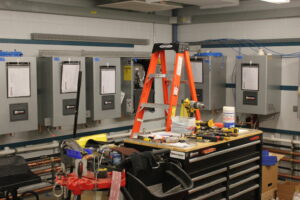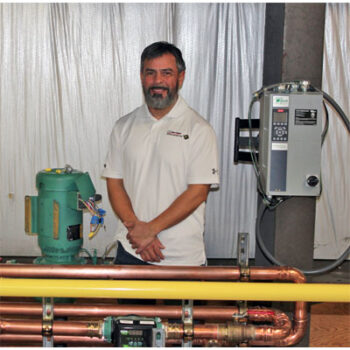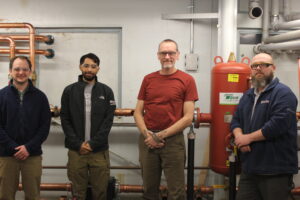by Duane Breneman and Lee Mowery
In several weeks, the cycle bay used by U.S. Boiler Company and other Burnham Holdings Subsidiaries will be complete. This space, located within our engineering lab, is used to perform accelerated lifecycle testing on boilers before we release them to our customers.
As production at U.S. Boiler Company has increased and new models are continually in development, we found our need almost exceeded our testing capacity. That was enough incentive to expand the cycle bay.
In the cycle bay, which is operated by Burnham Holdings Engineering Company, we vet control hardware and software, combustion settings, lifetime of mechanical components like pumps, three-way valves, burner durability, etc. The goal of this torture testing is to ensure that our products can endure conditions worse than what we expect them to encounter in the field. This process is a critical component of developing reliable products. A few examples of the conditions we apply to products in the cycle bay include worst-case load profiles, aggressive cycling, poor water quality, and electrical noise.
The work to upgrade and expand the cycle bay began in November 2023, and we anticipate firing boilers in the upgraded room in May of 2024.
Prior to the upgrades, we had capacity for 12 wall-hung and three floor-standing residential boilers. These boilers are operated for long periods of time at various firing rates, though often at full capacity. Firing the units obviously generates a lot of heat, and by 2023 we had exceeded the limit of our heat dissipation capacity.
Until this year, the cycle bay was tied in with the heat dissipation system that serves the 11 other test stations in our main lab. This existing system was designed to dissipate 5,000 MBH through two banks of fan coils, one evaporative cooling tower, and two chillers. With this setup, the lab test stations would experience significant changes in water temperature when equipment in the cycle bay cycled on and off. These fluctuations made it challenging to conduct performance tests that required consistent water temperatures.
Our work-around to that challenge was two-fold: we would offset boiler run times and we had to keep our chillers running 24/7.
During the upgrade, we isolated the cycle bay heat dissipation from the main lab for better water temperature control, to provide additional heat dissipation capacity, and to improve the overall layout. We also added a bank of fan coils, which increases our heat dissipation capacity by 2,000 MBH.
In addition to the increased heat dissipation capacity, we upsized piping and pumps to include 2-inch connections. We also removed some unused equipment from a previous project, opening up floor space to accommodate larger boilers.
Together, these changes allow us to test more boilers simultaneously and test larger boilers. Previously, we were limited to testing boilers with capacities up to 400 MBH. We can now test units up to 1,000 MBH. The revamped space accommodates 14 wall-hung boilers and six floor-standing boilers. Plus, we will no longer need to run our chillers round the clock, reducing both wear and tear on equipment and energy consumption.
Our team of technicians, under leadership of Sr. Product Development Engineer Lee Mowery and Lab Manager Vlad Babich, completed the piping and layout changes. U.S. Boiler Company’s maintenance team under Tyler Smith’s direction assisted with the electrical upgrades.
It’s worth mentioning that in the cycle lab, like elsewhere in the engineering lab, safety is paramount. In fact, the lab has achieved 3,200 days without a lost-time incident. Hearty congratulations are in order, especially to Vlad Babich and his team of lab technicians, for their continued efforts to maintain good housekeeping and keep each other safe.
# # #


